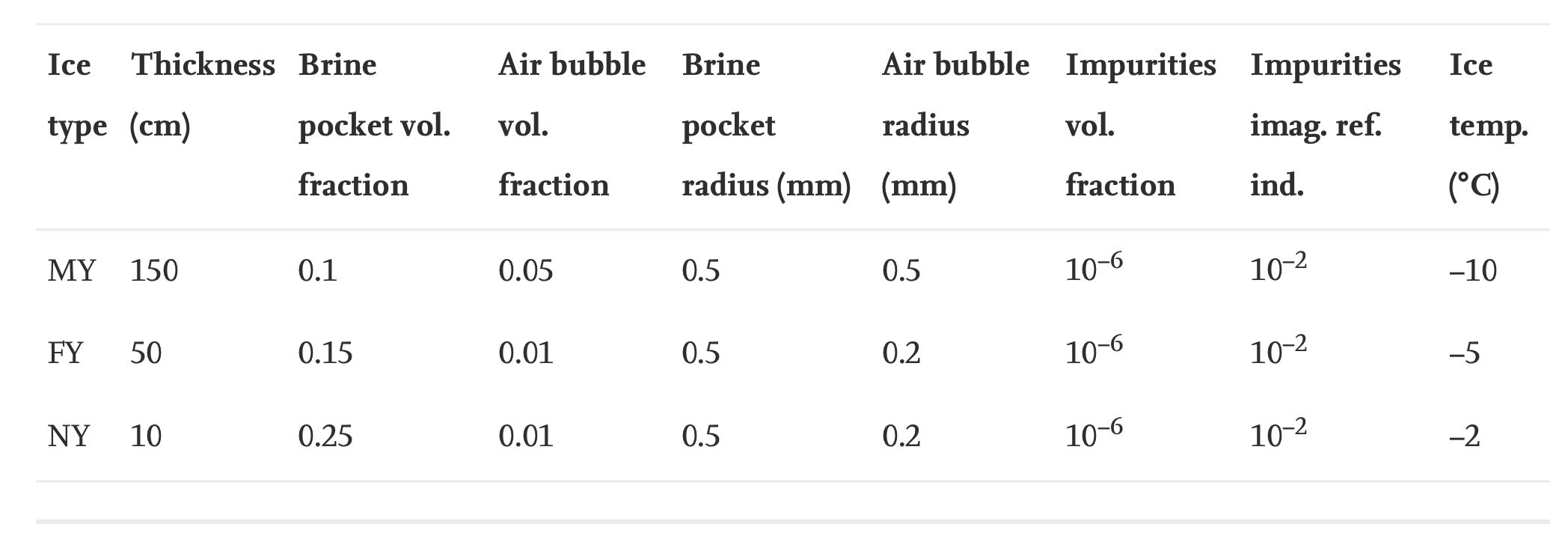Sea Ice Albedo Retrievals
Use Machine Learning and Deep Learning to predict sea-ice albedo in the polar regions with satellite radiance data
sea ice physical parameters:
brine pocket concentration effective brine pocket size,
air bubble concentration and effective air bubble size,
volume fraction of ice impurities and impurity absorption coefficient,
sea ice thickness.
angles of illumination and observation
snow physical parameters (snow effective grain size, density, and impurity concentration)
generate broad-band albedo over sea ice
Summary
Development of surface characterization sea ice albedo
Fitted equations that link each of the sea ice physical parameters with sea ice thickness.
Trained a 3-layer Neural Network model to retrieve broadband sea ice albedo based on radiance data, achieving 0.3% RMSE.
Achieved reasonable retrieval results when applied on MODIS images.
Application of the trained model to SGLI images (and testing/validation against MODIS results
) -- work in progress.
RT model for coupled atmosphere-sea ice/ocean system
Physical processes in the coupled atmosphere-sea ice/ocean system include:
Absorption and scattering by atmospheric molecules, clouds, and aerosols.
Absorption and scattering by snow.
Absorption by pure ice, and absorption and scattering by inclusions in sea ice (brine pockets and air bubbles).
Absorption and scattering by sea water and by hydrosols in the ocean.
Radiative Transfer Equation
Isolation of Azimuth Dependence
Air-Water Interface
Optical Properties and Parameterization of each stratum in the system:
Clouds: Equivalent Radius (ER) and the Liquid Water Content (LWC) of the clouds.
Snow: snow effective grain size, density, and impurity concentration.
Sea ice: brine pockets, air bubbles, ice temperature, density, and salinity.
Ocean: chlorophyll concentration.
Input Parameters:
Incident spectral radiation at the top of atmosphere.
Profiles of temperature, pressure, gas and aerosol concentrations in the atmosphere.
ER and LWC of clouds, cloud height, and thickness.
Surface temperature and snow conditions.
Profiles of temperature, salinity, and density in the ice; or profiles of volume fractions of gas and brine inclusions in the ice.
Vertical distribution of hydrosols in ocean.
Output Parameters:
Irradiances and mean intensities (scalar irradiances in Ocean Optics terminology) at specified vertical positions in the coupled system.
Total and polarized radiances in desired directions at specified vertical positions in the coupled system.
Generation of Synthetic Data Set
Generate angles of illumination and observation
Solar zenith angle: [20,80] degree
Sensor angle: [0.01~65] degree
Azimuth angle: [0.01~180] degree
Fit equations for sea ice physical parameters based on the table from

Table 1, Modeling of radiation transport in coupled atmosphere-snow-ice-ocean systems
Fit relations between ice thickness (m) with each of the other sea ice physical parameters based on the table.
aerosol optical depths

Graph 9, Modeling of radiation transport in coupled atmosphere-snow-ice-ocean systems
Generate tables of radiance of bare sea ice, snow-covered sea ice, and melting-pond covered sea ice at selected bands as well as broadband albedo were generated (run with xx streams) for each combination of sea ice type (NY, FY, MY) for a range of viewing geometries and wavelengths
Wavelength: Aerosol Optical Depth of background aerosols: solar: sensor: azimuth: snow thickness: [0, ) melting pond depth: [0, ) * snow thickness=0 & melting pond depth=0 for bare sea ice
Training of Neural Network
A 3-layer Neural Network, with ReLU (a=max(0,x)) as the activation function, was trained to predict albedos from visible(), near infrared(), and short wave range.
Graph
Visible
Near Infrared
Short Wave
Graph of RMSE
Application to Synthetic Data (sanity tests)
Graph cloud-masked image of broadband albedo with MODIS-channel radiance data
shows reasonable xx of xx
Application to real data
comparison between same day MODIS and SGLI sea ice albedo results
wait for Nan's cloud mask / or cut the corner
Future Work
Application to SGLI images (and testing/validation against MODIS results) is currently in progress.
Improve the albedo retrieval for thin, New Young (formed within 1 year) sea ice.
Surface classification during melting and snow-falling seasons based on albedo retrievals.
Sea ice physical parameters retrieval based on TOA albedo.
Last updated